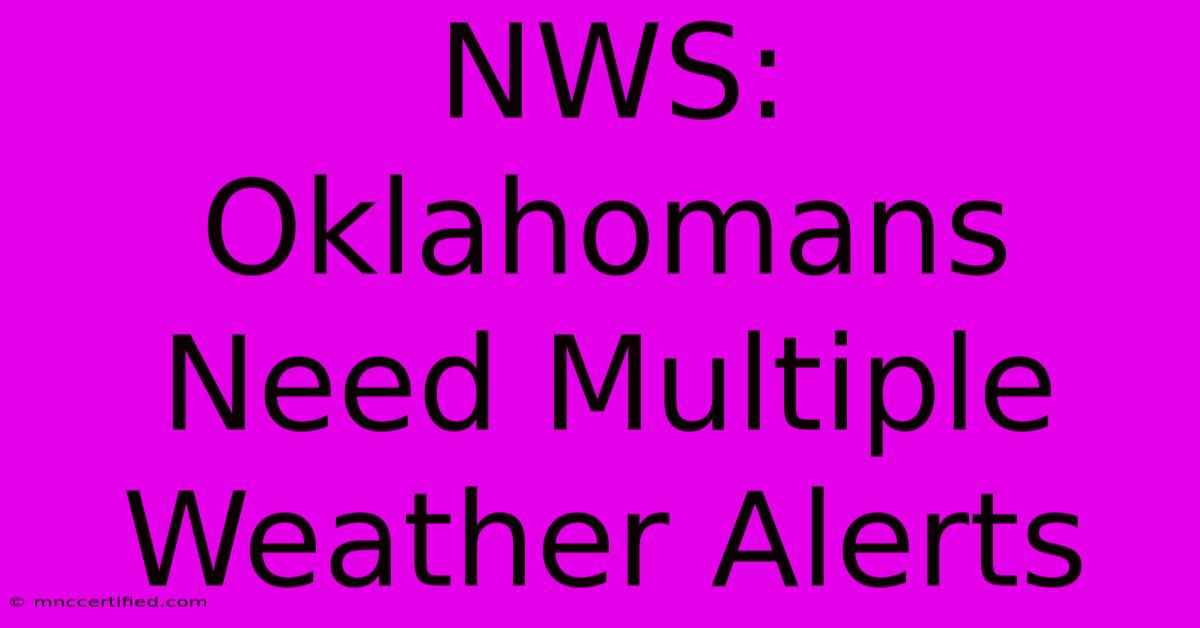NWS: Oklahomans Need Multiple Weather Alerts

Table of Contents
NWS: Oklahomans Need Multiple Weather Alerts – Why and How to Prepare
Oklahoma's weather is notoriously unpredictable, a volatile mix of sunshine, severe thunderstorms, tornadoes, and even blizzards. This isn't just folklore; it's a fact backed by years of data from the National Weather Service (NWS). That's why Oklahomans need multiple weather alerts – not just one – to stay safe. This article will explain why relying on a single alert source is insufficient and provide actionable steps to ensure you're prepared for whatever Mother Nature throws your way.
Why One Alert Isn't Enough: The Oklahoma Weather Reality
Oklahoma sits squarely in Tornado Alley, a region notorious for its intense and unpredictable weather systems. Relying solely on a single weather alert source, whether it's a weather app, a local news channel, or a siren, is simply not enough to guarantee your safety. Here's why:
-
Different Alert Systems, Different Information: The NWS utilizes various alert systems, including the Wireless Emergency Alerts (WEA), the National Oceanic and Atmospheric Administration (NOAA) Weather Radio, and various commercial weather apps. These systems may not always provide the same information simultaneously, and delays can occur.
-
Geographic Variations: Severe weather can develop rapidly and affect different areas of Oklahoma at different times. A warning issued for one county might not encompass a neighboring county until moments later. Multiple alerts provide a wider geographic coverage and increase your chances of early warning.
-
Specific Threat Levels: Not all alerts are created equal. A severe thunderstorm warning differs significantly from a tornado warning. Having access to multiple alerts allows you to understand the specific nature and severity of the imminent threat and tailor your response accordingly.
-
Alert System Failures: Technical difficulties can affect any alert system. A power outage might silence your NOAA Weather Radio, while a server overload could temporarily disrupt your weather app. Having backup alert systems is crucial for redundancy.
Multiple Weather Alerts: Your Best Defense
To adequately protect yourself and your family, consider these strategies for receiving multiple weather alerts:
1. NOAA Weather Radio: The Gold Standard
NOAA Weather Radio is a dedicated all-hazards weather radio that broadcasts continuous weather information directly from the NWS. It's considered the gold standard due to its reliability and its ability to broadcast warnings even during power outages (battery-powered models are available).
2. Wireless Emergency Alerts (WEA): Your Phone's Built-in System
Most smartphones come equipped with WEA, which delivers critical alerts directly to your phone, even if the phone is in silent mode. However, remember that WEA alerts can be delayed, so don't solely rely on this system.
3. Reputable Weather Apps: Convenience and Additional Information
Numerous weather apps offer detailed forecasts, radar imagery, and real-time alerts. Choose reputable apps from established sources and ensure that your location settings are accurate. Remember that these apps rely on data from the NWS, which can lead to occasional delays.
4. Local News and Television:** Ground-Level Reporting
Local news channels offer ground-level reporting and on-the-scene updates which can provide valuable context alongside NWS alerts.
5. Outdoor Warning Sirens:** A Supplementary Alert
While outdoor sirens are invaluable for alerting the public to imminent danger, they are designed primarily for outdoor warning. They may not be audible indoors and don't provide specific details about the threat.
Beyond Alerts: Proactive Preparedness
While multiple weather alerts are crucial, they're only part of the equation. Proactive preparedness is equally important:
- Develop a family emergency plan: Determine a safe room, establish communication protocols, and pack an emergency kit.
- Stay informed: Regularly check weather forecasts and heed all warnings from the NWS.
- Understand the difference between watches, warnings, and advisories: Knowing the distinctions will help you respond appropriately.
- Practice your emergency plan regularly: Familiarize yourself with escape routes and assemble your emergency kit.
Oklahoma's weather demands a multi-faceted approach to safety. By utilizing multiple alert systems, staying informed, and preparing proactively, you can significantly reduce your risk and increase your chances of weathering the storm – literally.

Thank you for visiting our website wich cover about NWS: Oklahomans Need Multiple Weather Alerts. We hope the information provided has been useful to you. Feel free to contact us if you have any questions or need further assistance. See you next time and dont miss to bookmark.
Featured Posts
-
A12 Northbound Closed Due To Multiple Crashes
Nov 18, 2024
-
Berkley Southeast Insurance Group
Nov 18, 2024
-
Maplestory Shared Cash Shop Items
Nov 18, 2024
-
Danny Jones Reveals Hidden Talent
Nov 18, 2024
-
I M A Celebrity Barrys Funny Connection
Nov 18, 2024